Description[]
This can be made with the small fruited native North American common persimmon (Diospyros virginiana) or with the larger fruited Hachiya Japanese persimmon (Diospyros kaki). The native fruits give a waxy, but not tough, consistency to the pudding; however, often are not as juicy as the Hachiya so you may need to use only ½ cup of flour when using the natives.
Both of these types of persimmons need to ripen to the point that they almost become a liquid barely contained within a fragile thin skin before that they lose their astringency. There are other types of persimmons where that this is not the case. The American persimmon must ripen on the tree and fall on the ground before that it is ripe. Many are badly damaged when they fall; however, it is rare for an unripe astringent persimmon to fall from the tree and those still hanging on the tree are almost never ripe. Their thin skin will begin to wrinkle when ripe and may be develop a whitish coating. The most desirable American persimmons usually start ripening in mid-August, long before frost with a peak for flavor in early September. The fruit on a native American persimmon tree usually does not ripen all at once and may ripe from mid-August to mid-October. By early October, just before frost, they are not near as desirable to eat as that they were earlier.
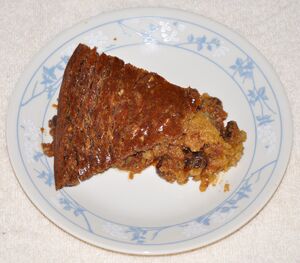
Persimmon Pudding Serving
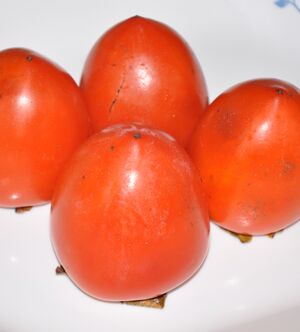
Ripe Hachiya persimmons
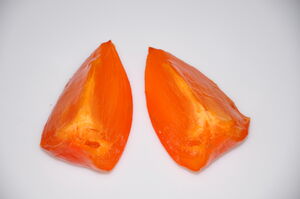
Ripe Hachiya persimmon slices
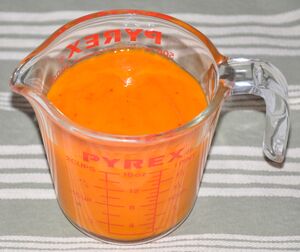
Persimmon puree
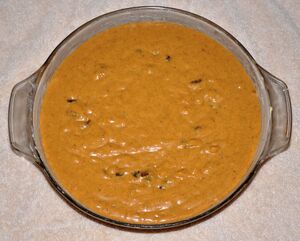
Persimmon pudding before baking
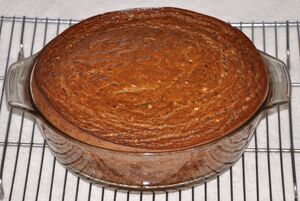
Persimmon pudding fresh out of the oven before cooling and shrinking
The Hachiya persimmon will ripen off of the tree; however, they are almost never ripe in the store as when they are ripe, they are so delicate that they would mash into a pulpy mess in your bag on the way home from the grocery store. You may need to buy the Hachiya persimmons 1 to 2 weeks or more before using in order to allow time for them to ripen. You may need to buy 8 or more Hachiya persimmons as some may spoil during ripening and sometimes they do not ripen evenly and you will need to cut out any flesh that is still firm. The skin will start to wrinkle on the Hachiya persimmons when ripe. They may burst into a liquid like pulp when cut rather than making the clean cut slices seen in the picture below and to the right. That is okay if that happens as long as the flesh/pulp is not actually spoiled. Use them up immediately if that you start to see black dots appear on the skins. It takes about 4 1/2 large Hachiya persimmons to make the required 2 cups of persimmon pulp.
Some families traditionally buy the Hachiya persimmons a week or so before christmas to be used as decorations in a bowl in the middle of a large dining table and then serve pudding made from the persimmons on new year’s eve or day. Hachiya persimmons are usually seasonably available in stores starting a couple of weeks before thanksgiving.
- Makes 8 servings
Ingredients[]
- 2 cups Hachiya persimmon pulp
- ½ cup melted Fleischmann’s Original margarine
- 3 eggs, beaten
- 2½ cups rich milk
- 1¼ cups sugar
- 2 teaspoons cinnamon
- 1½ cups all-purpose flour
- 1 teaspoon ginger
- 1 teaspoon any baking powder
- ½ teaspoon freshly grated nutmeg (1 tsp dry)
- 1 teaspoon baking soda
- 1 cup raisins
- ½ teaspoon salt
- 1 cup chopped English walnuts
Hard Sauce[]
- 8 ounces whipped unsalted butter, softened
- 1 egg yolk
- pinch of salt
- 4 tablespoons heavy cream
- 2 cups sifted confectioners' sugar
- 4 tablespoons cognac
Directions[]
- Preheat the oven to 325ºF.
- Use a colander to separate out the persimmon seeds from the pulp if using native American persimmons. The Japanese persimmons usually don’t have seeds.
- Once the seeds and dried sepals are removed, add both the pulp and the skin to a blender and make a puree.
- One can of coconut milk (13.5 ounces) diluted with water until you have 2 ½ cups liquid works very well as a substitute for the rich milk.
- Coco King brand coconut milk with 23-25% daily value of fat is my favorite.
- Mix the milk, melted margarine, eggs and persimmon puree in a blender.
- Pour into a large mixing bowl.
- This mixture may start to set up like a pudding because of the high soluble fiber content of the persimmons; however, you will be able to break it up easily by stirring and return it to a liquid state.
- Sift the dry ingredients together except for the raisins and walnuts.
- Add everything to the large mixing bowl.
- Mix well.
- Bake the pudding in an uncovered, greased 9 x 3 inch heavy glass casserole dish until softly firm (there should be movement when tilted) about 80 minutes. Bake 75 minutes if serving the following day.
- Let sit for 5 minutes and then run a sharp knife around the edge between the glass and the pudding to aid in releasing later. Let sit uncovered another 50 minutes as the pudding will continue to cook and set up after you have removed it from the oven.
- The leftover pudding will slice very cleanly the following day after being refrigerated.
- You may want to consider slightly less baking time as some liquid in the center can make a wonderful sauce to spoon over the pudding.
- Leftovers that have the liquid in the middle, microwave quite well.
- Topping the pudding with hard sauce, whipped cream or topping is recommended.
Hard Sauce[]
- Put ingredients in a food processor and mix until smooth and creamy.
- Put sauce in tightly covered jar.
- Refrigerate.
- Remove from refrigerator at least 1 hour before serving.
